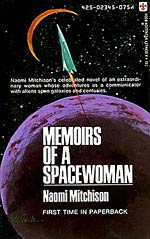
![]() couchtomoon
couchtomoon
7/18/2015
![]()
Hats off to Joachim at Science Fiction and Other Suspect Ruminations for his promotion of this underappreciated sci-fi jewel from the early 1960s. First published in 1962 by Gollancz, then reprinted by The Women's Press in London in 1985, it's no argument that this novel has experienced swings of attention at times, yet without a place on any of the major SF lists, and despite Mitchison's long literary career, its memory as a critical piece of genre is threatened.
In Memoirs, we meet Mary, a communication specialist for Terran interstellar missions in the far undetermined future. She writes about some of her more memorable experiences in this capacity, describing the strange planets and beings she has visited, including her struggles to decode the various unique ways other beings communicate, including by touch and telepathy. Her memoirs also reflect upon her relationships with former lovers, a couple of unusual pregnancies, and the way in which parent/child affiliations have changed in the far future, particularly when interstellar space travel is involved.
A kind of anthropologist, Mary inserts herself into these strange alien civilizations to decode the mostly nonverbal communications of lifeforms drastically different from humans. Ambigendered Martians. Psychic radiates. Centipede-like creatures with brain matter smeared on their sides. Oozy tissues that symbiose with Terran hosts in a kind of pregnancy. Giant butterflies in need of some surgical lessons on C-sections. Mitchison presents a wide variety of strange lifeforms, all encapsulated in this little novel, making this the most creative book I've read about alien cultures.
Themes of blame and guilt are touched upon in each of Mary's stories, starting with her bungled operation with the blood-thirsty Epsies, where her objectivity as a scientist is colored by her own surprise at their disturbing behaviors and her guilt over her subsequent judgment of these creatures. She learns from her mission leader, "humiliation, however it was produced, was a necessary stage in exploration" (45). Following chapters hint at her guilt over a couple of misguided pregnancies, which produce a haploid Martian daughter, and a couple of unsuccessful alien grafts. She sometimes regrets the estrangement that life among the stars causes between herself and her children and lovers (although this is the norm for her society).
Then, the longest of the tales, Mary introduces us to a planet where happy, innocent caterpillars engage in fecal art displays and group sexual wallowing, until angry butterflies attack with a psychic guilt ambush:
The wretched caterpillars curled up or crept aside, the colours paled, the eye spots dimmed. They seemed to shrivel as from an inward searing. We watched with intent sympathy,... Yet we were also aware of the attackers, the whirl and flurry of wings, the colours beyond anything I have ever perceived on any planet of any sun, the antennae stiff and pointing like weapons of offence, the legs glittering and jointed as strange armour might have been.
...Even if one is not directly under it, such a torrent of blame is unnerving (92).
Clearly a commentary on emotional abuse and the paralyzing guilt it creates, as well as an absurdist reframing of moral attitudes toward idleness and sexuality, but it's also a cool alien depiction that is both bizarre and ambiguous. The scientists soon figure out this strange and puzzling situation, but find themselves at odds with their objective constraints and moral inclinations to intervene and educate the butterflies, and it's never clear whether the butterflies' behavior, disturbing as it is, is appropriate. As one of Mary's colleagues takes decisive action, serious consequences occur and the mission is terminated early.
Lots of focus on sexuality and weird pregnancies put this book in the danger zone of bad SF cliché, and I'll be the first to admit I run screaming from weird pregnancy fiction, so I can understand why some people might choose to ignore this book. It doesn't help that Mitchison's narrative embraces many of the deterministic gender values of the day, when valuing women means reinforced gender coding ("I always feel that biology and, of course, communication are essentially women's work, and glory" 18). But ignore that because Mitchison touches all the right sci-fi buttons: she captures the imagination without the neon-colored message flags one might expect from feminist science fiction. This is pure science fiction: weird, wondrous, and way out there.
Speaking of alien communication, sexuality, and gender determinism, I also view this as a suitable companion piece to its timeline peer, the 1961 award-winning Stranger in a Strange Land. Read both and tell me which one feels more relatable, relevant, and genuinely "of the future," and which one feels like poorly-aged, sixties schlock.
http://couchtomoon.wordpress.com